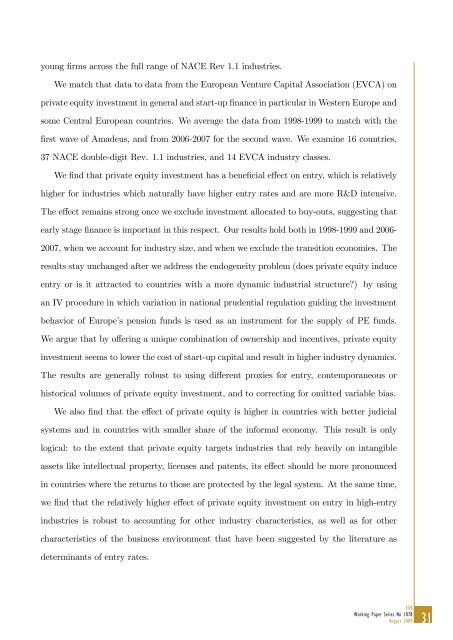On the real effects of private equity investment: evidence from new ...
On the real effects of private equity investment: evidence from new ...
On the real effects of private equity investment: evidence from new ...
- No tags were found...
Create successful ePaper yourself
Turn your PDF publications into a flip-book with our unique Google optimized e-Paper software.
young …rms across <strong>the</strong> full range <strong>of</strong> NACE Rev 1.1 industries.We match that data to data <strong>from</strong> <strong>the</strong> European Venture Capital Association (EVCA) on<strong>private</strong> <strong>equity</strong> <strong>investment</strong> in general and start-up …nance in particular in Western Europe andsome Central European countries. We average <strong>the</strong> data <strong>from</strong> 1998-1999 to match with <strong>the</strong>…rst wave <strong>of</strong> Amadeus, and <strong>from</strong> 2006-2007 for <strong>the</strong> second wave. We examine 16 countries,37 NACE double-digit Rev. 1.1 industries, and 14 EVCA industry classes.We …nd that <strong>private</strong> <strong>equity</strong> <strong>investment</strong> has a bene…cial e¤ect on entry, which is relativelyhigher for industries which naturally have higher entry rates and are more R&D intensive.The e¤ect remains strong once we exclude <strong>investment</strong> allocated to buy-outs, suggesting thatearly stage …nance is important in this respect. Our results hold both in 1998-1999 and 2006-2007, when we account for industry size, and when we exclude <strong>the</strong> transition economies. Theresults stay unchanged after we address <strong>the</strong> endogeneity problem (does <strong>private</strong> <strong>equity</strong> induceentry or is it attracted to countries with a more dynamic industrial structure?) by usingan IV procedure in which variation in national prudential regulation guiding <strong>the</strong> <strong>investment</strong>behavior <strong>of</strong> Europe’s pension funds is used as an instrument for <strong>the</strong> supply <strong>of</strong> PE funds.We argue that by o¤ering a unique combination <strong>of</strong> ownership and incentives, <strong>private</strong> <strong>equity</strong><strong>investment</strong> seems to lower <strong>the</strong> cost <strong>of</strong> start-up capital and result in higher industry dynamics.The results are generally robust to using di¤erent proxies for entry, contemporaneous orhistorical volumes <strong>of</strong> <strong>private</strong> <strong>equity</strong> <strong>investment</strong>, and to correcting for omitted variable bias.We also …nd that <strong>the</strong> e¤ect <strong>of</strong> <strong>private</strong> <strong>equity</strong> is higher in countries with better judicialsystems and in countries with smaller share <strong>of</strong> <strong>the</strong> informal economy. This result is onlylogical: to <strong>the</strong> extent that <strong>private</strong> <strong>equity</strong> targets industries that rely heavily on intangibleassets like intellectual property, licenses and patents, its e¤ect should be more pronouncedin countries where <strong>the</strong> returns to those are protected by <strong>the</strong> legal system. At <strong>the</strong> same time,we …nd that <strong>the</strong> relatively higher e¤ect <strong>of</strong> <strong>private</strong> <strong>equity</strong> <strong>investment</strong> on entry in high-entryindustries is robust to accounting for o<strong>the</strong>r industry characteristics, as well as for o<strong>the</strong>rcharacteristics <strong>of</strong> <strong>the</strong> business environment that have been suggested by <strong>the</strong> literature asdeterminants <strong>of</strong> entry rates.ECBWorking Paper Series No 1078August 200931















